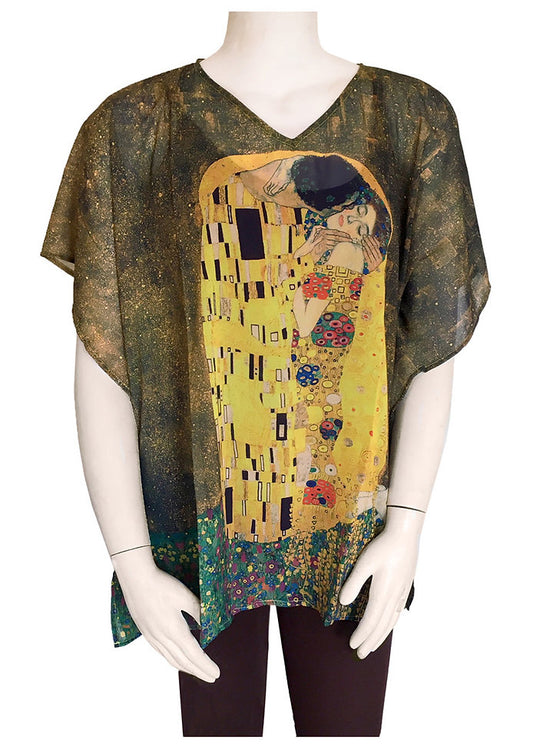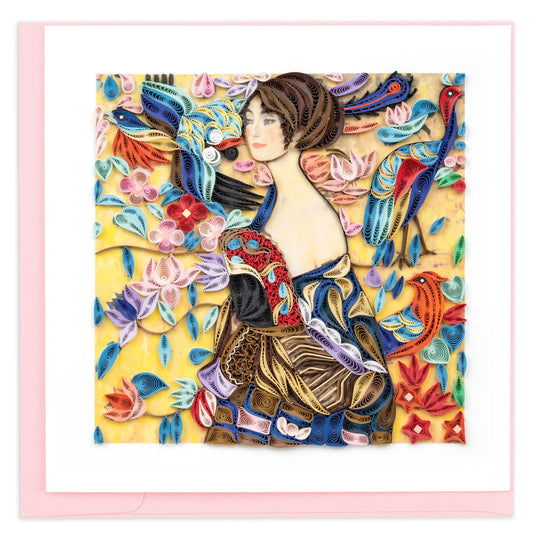Artist Series Quilling Card: "The Lady In Gold" by Gustav Klimt
Artist Series Quilling Card: "The Lady In Gold" by Gustav Klimt
Out of Stock
Couldn't load pickup availability
The Lady in Gold by Gustav Klimt, also known as Portrait of Adele Block-Bauer, was completed between 1903 and 1907. This painting was one of two portraits commissioned by Ferdinand Block-Bauer of his wife when she was 25 years old. The painting has a complicated history as it was stolen by the Nazis from the Block-Bauer family during WWII. It now resides at the Neue Galerie in New York City. Some have even come to refer to the portrait as the “Mona Lisa of Vienna”.
Quilling Cards' Artist Series artfully transforms paint strokes into paper strips using the ancient art of quilling. Each card takes several hours to make and reimagines a famous work of art into a magnificent greeting card that can either be sent and shared with loved ones or kept and framed as the work of art it is.
- Additional postage required when mailing
- Blank inside
- Color coordinated envelope included
- Suitable for framing
Product Details
Product Details
- Product type: Blank Note Card
- Shipping Dimensions: 6.0 × 6.0 × 0.125 inches (15.2 × 15.2 × 0.3 cm)
- Shipping Weight: 0.19 lb (3.0 oz; 85 g)
- SKU: SKU: SKU010008765
- UPC: 843425108858
- Part No.: AS0005
Share








-
Quilled by Hand
Quilling, also known as paper filigree, is a paper art technique that involves shaping, rolling, and gluing strips of paper into decorative designs.
-
Social Enterprise
Social enterprises seek to maximize profits while maximizing benefits to society and the environment, and the profits are principally used to fund social programs.
-
Woman Owned Business
At least 51% of this business is owned and operated by women.

About the Artist
Gustav Klimt
Gustav Klimt (1862 — 1918) was an Austrian symbolist painter and one of the most prominent members of the Vienna Secession movement. Klimt is noted for his paintings, murals, sketches, and other objects d'art. Klimt's primary subject was the female body, and his works are marked by a frank eroticism.
More Gustav Klimt
-
Sugar-Free Mints Tin: The Tree of Life
Regular price $4.95 USDRegular priceUnit price / per -
Lenticular Postcard: Klimt (The Kiss)
Regular price $3.25 USDRegular priceUnit price / per -
Lenticular Postcard: Klimt (The Kiss)
Regular price $3.25 USDRegular priceUnit price / per -
Lenticular Postcard: Klimt (Mother and Child)
Regular price $3.25 USDRegular priceUnit price / per -
Quilled Bookmark: Klimt The Kiss
Regular price $6.95 USDRegular priceUnit price / per -
Sticker: Klimt's "The Kiss"
Regular price $4.00 USDRegular priceUnit price / per -
Gustav Klimt 2026 Wall Calendar
Regular price $16.99 USDRegular priceUnit price / per -
Enamel Magnet: Klimt's The Kiss
Regular price $11.95 USDRegular priceUnit price / per -
Pop-over Tunic: Gustav Klimt's "The Kiss"
Regular price $69.95 USDRegular priceUnit price / per -
Artist Series Quilling Card: "Lady With A Fan" by Gustav Klimt
Regular price $30.00 USDRegular priceUnit price / per

About the Vendor
Quilling Card
Quilling is the art of rolled, shaped, and glued paper that results in creating a unified, decorative design. The name quilling is thought to come from the origin of the art; birds’ feathers, or quills, were used to coil the strips of paper around.
Since 2015, Quilling Card has been certified with the Fair Trade Federation. The organization focuses on maintaining a code of values for just treatment of employees. With the rapid expansion of the business, Quilling Card employs over 500 quillers in two locations, providing a stable and safe work environment, with healthcare and food benefits for its employees.
-
Made by Hand
Hand crafted with love.
-
Minority Business Enterprise
Certified Minority Business Enterprise. At least 51% of the business is owned and operated by Black American, Hispanic, Native American, Asian Pacific, or Subcontinent Asian people.
-
Woman Owned Business
At least 51% of this business is owned and operated by women.
-
Museum Store Association Member
The Museum Store Association supports the cultural non-profit retail industry and the people who work in it.
-
Certified Fair Trade
Certified Fair Trade by Fair Trade International.
More from Quilling Card
-
Shadowbox Frame
Regular price $22.00 USDRegular priceUnit price / per -
Quilled Royal Guard Note Card CLEARANCE
Regular price $6.00 USDRegular priceUnit price / per$12.00 USDSale price $6.00 USDSale -
Quilled Royal Guard Teddy Bear Note Card CLEARANCE
Regular price $6.00 USDRegular priceUnit price / per$12.00 USDSale price $6.00 USDSale -
Quilled Double Decker Bus Note Card CLEARANCE
Regular price $6.00 USDRegular priceUnit price / per$12.00 USDSale price $6.00 USDSale -
Quilled Red Telephone Box Note Card CLEARANCE
Regular price $6.00 USDRegular priceUnit price / per$12.00 USDSale price $6.00 USDSale -
Quilled Big Ben Note Card CLEARANCE
Regular price $6.00 USDRegular priceUnit price / per$12.00 USDSale price $6.00 USDSale -
Frame for Artist's Series Quilling Cards (Rectangle, Gold)
Regular price $40.00 USDRegular priceUnit price / per -
Frame for Artist's Series Quilling Cards (Square, Black)
Regular price $40.00 USDRegular priceUnit price / per -
Artist Series Quilling Card: "Woman with a Parasol" by Claude Monet
Regular price $30.00 USDRegular priceUnit price / per -
Artist Series Quilling Card: "Composition" by Piet Mondrian
Regular price $30.00 USDRegular priceUnit price / per




























